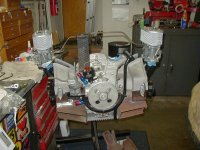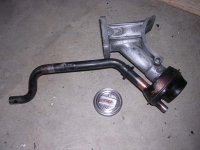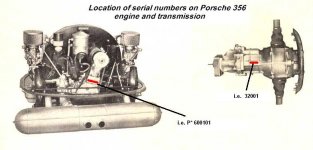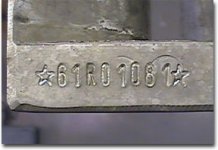-
Please be sure to read the rules and adhere to them. Some banned members have complained that they are not spammers. But they spammed us. Some even tried to redirect our members to other forums. Duh. Be smart. Read the rules and adhere to them and we will all get along just fine. Cheers. :beer: Link to the rules: https://www.forumsforums.com/threads/forum-rules-info.2974/
You are using an out of date browser. It may not display this or other websites correctly.
You should upgrade or use an alternative browser.
You should upgrade or use an alternative browser.
VW Engine I.D. "At a glance"
- Thread starter Lyndon
- Start date
In 1961 they came out with the 40 HP, or 1192 CC. It was produced thru 1965. One to two million a year. Toward the end of production is became "Clean-Air". All Pre-Clean-Air engines had STALE AIR HEAT and their fan housings have no hoses coming out of them.
All the Stale air engines have fan housings that look like this:
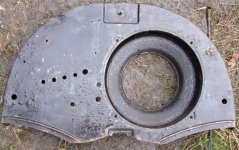
Stale Air engines took air directly off the engine thru some small sort of excuse for a heat exchanger mounted on the rear of the engine. Oil fumes and burnt bugs and grass also blew right into the heat system.
All the Stale air engines have fan housings that look like this:

Stale Air engines took air directly off the engine thru some small sort of excuse for a heat exchanger mounted on the rear of the engine. Oil fumes and burnt bugs and grass also blew right into the heat system.
Only the last year of 40 HP is clean air. Clean Air engines have the foil or black foil and paper tube eminating from the front of the fan housing. This air bypassed the engine and went to a real heat exchanger made of aluminum moulded to the front exhaust tubes. It is essential to plug these off if you don't have the tubes in place. Failure to do so reduces air flow to the engine enough to cause overheating.


In 1966 they came out with the "1300" and it produced 53 HP. It was also the first year of 12 Volt. 1300's were especially good engines and the cylinders off 1500, and 1600's can be retrofitted to them. From this point on one has to go by the letter designator on the block right below the pedistal. The Serial Number is prefixed by a single or two letters.

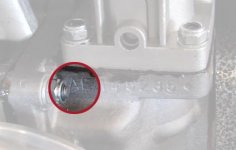


From 1968/1969 on they produced the 1600 which ranges from 55 HP to 65 HP. The letter designator for a 1300 is H and they are all covered in the "Idiot Book". What's not covered in John Muir's book is VW Industrial engines. They are 116 of 126 engines have have this preceeding the serial number as well as on the intake manifold.
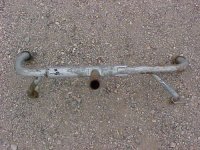
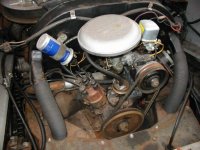


Lyndon I have a sn on a suction dredge i"m trying to ID, sn is 3489757
Lydon,
What are the differences between the industrial engines and the car engines? For snow cat duty, is there a good reason to stay with the industrial engines? The domestic car manufactures used to offer "industrial" versions of there car engines. They had things like stellite or sodium filled vales, larger oil pans and radiators, hardened valeseats and rotators, that the automotive versions didn't have. I am imagining VW did some thing similar with their's?
Great information for those of us who would like to get to know the air cooled VW engines. Thank you!
Regards, Kirk
What are the differences between the industrial engines and the car engines? For snow cat duty, is there a good reason to stay with the industrial engines? The domestic car manufactures used to offer "industrial" versions of there car engines. They had things like stellite or sodium filled vales, larger oil pans and radiators, hardened valeseats and rotators, that the automotive versions didn't have. I am imagining VW did some thing similar with their's?
Great information for those of us who would like to get to know the air cooled VW engines. Thank you!
Regards, Kirk
I'm not a real expert on VW Industrials, or for that matter on anything else! Here's what I do know:
FACTS:The 1192 CC 4o HP version, only actually produced 35 HP.
I know nothing about the 36 HP predacessor except that they did build them.
All of the VW industrials had Small diameter Geenerators. When the cars up-graded to 12 Volt they increased the size of the generator. Only one year of BUS (65) had the small diameter 12Volt generator. Porsches had the small diameter 12 volt generator so when you go to replace or rebuild one the parts house or rewind shop goes: AHH,... a porsche part,... we can charge 3 times as much for that!
They originally come from the factory with a 'Rev Limiter', a crude sort of speed govenor that won't let you over speed the engine. It's a special spring loaded distributor rotor. Centrifugal force caused it to interrupt the spark above a certain RPM's.
All VW Industrials had Manual Choke even when the cars of the same year were being outfitted with automatic electric chokes.
All the VW Industrials had the "Hand Crank Nut". This feature was dropped in 1960 with the end of production of the 36 HP for automobiles.
I know nothing about the 1300 & 1500 versions all of my experience has been with the 1584 CC, "1600", and it is a very good VW motor. It has a slightly longer stroke that equivalent VW 1600 Bug engines, and a larger intake manifold than the first few years of 1600 Bug engines. It also has Higher compression, 10 : 1. And even though the advertised HP is 53 or 54 HP, they actually produce around 60 HP, stock with no modifications.
They were used for: Generator Sets, to power Welders and Pumps, for Saw Mills, and Roofing Tar Pumps. Most ZAMBONI's have a VW Industrial. Thats the machine you see on Ice Skating Rinks that surfaces the ice. Most of these were propagne powered. A guy in N.Y. rebuilt them and HE was considered the real expert on VW industrials. I never got to meet him, just heard about him. I don't know if he's still alive, he was old when in the 70's,...
Some aircraft, and various pieces of farm equipment were also equipped with VW Industrials.
(3) makes of Snow cat had VW engines, Snow Trac, Kristi, and Tucker Snow Cat.
FACTS:The 1192 CC 4o HP version, only actually produced 35 HP.
I know nothing about the 36 HP predacessor except that they did build them.
All of the VW industrials had Small diameter Geenerators. When the cars up-graded to 12 Volt they increased the size of the generator. Only one year of BUS (65) had the small diameter 12Volt generator. Porsches had the small diameter 12 volt generator so when you go to replace or rebuild one the parts house or rewind shop goes: AHH,... a porsche part,... we can charge 3 times as much for that!
They originally come from the factory with a 'Rev Limiter', a crude sort of speed govenor that won't let you over speed the engine. It's a special spring loaded distributor rotor. Centrifugal force caused it to interrupt the spark above a certain RPM's.
All VW Industrials had Manual Choke even when the cars of the same year were being outfitted with automatic electric chokes.
All the VW Industrials had the "Hand Crank Nut". This feature was dropped in 1960 with the end of production of the 36 HP for automobiles.
I know nothing about the 1300 & 1500 versions all of my experience has been with the 1584 CC, "1600", and it is a very good VW motor. It has a slightly longer stroke that equivalent VW 1600 Bug engines, and a larger intake manifold than the first few years of 1600 Bug engines. It also has Higher compression, 10 : 1. And even though the advertised HP is 53 or 54 HP, they actually produce around 60 HP, stock with no modifications.
They were used for: Generator Sets, to power Welders and Pumps, for Saw Mills, and Roofing Tar Pumps. Most ZAMBONI's have a VW Industrial. Thats the machine you see on Ice Skating Rinks that surfaces the ice. Most of these were propagne powered. A guy in N.Y. rebuilt them and HE was considered the real expert on VW industrials. I never got to meet him, just heard about him. I don't know if he's still alive, he was old when in the 70's,...
Some aircraft, and various pieces of farm equipment were also equipped with VW Industrials.
(3) makes of Snow cat had VW engines, Snow Trac, Kristi, and Tucker Snow Cat.
VW of Germany never knew just what a customer was going to use one of their Industrial engines for. With this in mind they tried to build them assuming the worst, that they would be left unattended, at full throttle like when running a generator or pump. That's why they had rev limiting distributor rotors. There was gossip about them having better balanced cranks, but that's not substantiated. Porsche's had sodium filled valves that had been EX-RAYED, so if one needed real reliability they just upgraded to a Porsche. They also had really well balanced cranks and domed piston sets. The Porsche 356 engine came in 60,(N), 75(SC), and 90(Super '90') HP. Instead of topping out at 4600 RPM's they would operate to 6500 RPM's reliably. They had a beefy oil system, bigger intakes and exhaust, angled valves, and additional main bearing,..... and lots of other performance and durability enhancing features. The Porsche Industrial just came in the 60 HP version I believe and would have been fairly "Bullet-Proof".
on the 36 horse motors as a young kid i remember helping my dad rebuild a 36 horse at alexandre lake it had the bottom end of the 34 hose motor and the topend of the 40 horse i remember dad having to buy 2 rebuild kits to rebuild the motor.I'm not a real expert on VW Industrials, or for that matter on anything else! Here's what I do know:
FACTS:The 1192 CC 4o HP version, only actually produced 35 HP.
I know nothing about the 36 HP predacessor except that they did build them.
All of the VW industrials had Small diameter Geenerators. When the cars up-graded to 12 Volt they increased the size of the generator. Only one year of BUS (65) had the small diameter 12Volt generator. Porsches had the small diameter 12 volt generator so when you go to replace or rebuild one the parts house or rewind shop goes: AHH,... a porsche part,... we can charge 3 times as much for that!
They originally come from the factory with a 'Rev Limiter', a crude sort of speed govenor that won't let you over speed the engine. It's a special spring loaded distributor rotor. Centrifugal force caused it to interrupt the spark above a certain RPM's.
All VW Industrials had Manual Choke even when the cars of the same year were being outfitted with automatic electric chokes.
All the VW Industrials had the "Hand Crank Nut". This feature was dropped in 1960 with the end of production of the 36 HP for automobiles.
I know nothing about the 1300 & 1500 versions all of my experience has been with the 1584 CC, "1600", and it is a very good VW motor. It has a slightly longer stroke that equivalent VW 1600 Bug engines, and a larger intake manifold than the first few years of 1600 Bug engines. It also has Higher compression, 10 : 1. And even though the advertised HP is 53 or 54 HP, they actually produce around 60 HP, stock with no modifications.
They were used for: Generator Sets, to power Welders and Pumps, for Saw Mills, and Roofing Tar Pumps. Most ZAMBONI's have a VW Industrial. Thats the machine you see on Ice Skating Rinks that surfaces the ice. Most of these were propagne powered. A guy in N.Y. rebuilt them and HE was considered the real expert on VW industrials. I never got to meet him, just heard about him. I don't know if he's still alive, he was old when in the 70's,...
Some aircraft, and various pieces of farm equipment were also equipped with VW Industrials.
(3) makes of Snow cat had VW engines, Snow Trac, Kristi, and Tucker Snow Cat.
I have a lot of friends that have been VW mechanics for many years.So here is what they tell me.As Lyndon said Carb & dist are different.Internals all the same as regular VW's.Why not if you don't over rev them they do 3-5000 miles without adjusting valves.720 hr = 1 month.I work on Detroits,Cummins,Wakasha,Cats & various others that run on natural gas running compressors.We shut them down every 1500 - 2000 hrs and lash valves,change oil.My 3 of my friends worked for VW back in the day befor liquid cooled came into the picture.I adjust lash the valves on my air cooled VW's about every 1000-1500 miles because I can & it gives me a good reason to go to the shop.My 2 bucks worth.Sorry bfor rambling
Peter
Peter
Thanks Lyndon and Peter,
Sounds like valve train adjustment is very important to keep up on the air cooled VW motors. Especially if they are revved up top red line alot? Or just as a matter of course as the operating hours add up......or both?
Great information, clears up some of my questions...Thanks
Regards, Kirk
Sounds like valve train adjustment is very important to keep up on the air cooled VW motors. Especially if they are revved up top red line alot? Or just as a matter of course as the operating hours add up......or both?
Great information, clears up some of my questions...Thanks
Regards, Kirk

